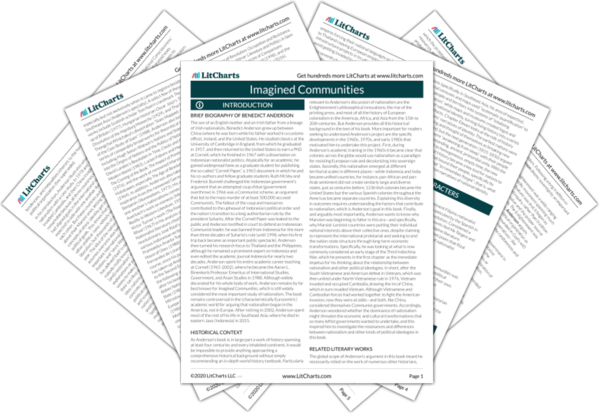Anderson uses anthropologist Victor Turner’s analysis of the pilgrimage to represent one way in which the administrative structure of European empires contributed to the structure of nationalist movements in former colonies. He sees the creole classes’ travels as a crucial factor in the development of a geographical consciousness: by going to the capital to work or study, people gained an awareness of their specific national, linguistic, and cultural characteristics in comparison to those of others who make the same pilgrimage. The pilgrimage also allows Anderson to show the continuity between nations and other cultural phenomena, like religions or rituals, which all exist primarily on the level of imagination and emotion. As a ritual, the pilgrimage transforms people’s identities by offering them a symbolic sense of home—loyalty and belonging to the place from whence they come. Anderson takes up a handful of specific examples of the pilgrimage. For one, the fact that creole bureaucrats in the Spanish Empire could never get jobs outside their own territories was one of the most important reasons that this empire broke up into more than a dozen different sovereign states after gaining independence from Spain—while, in North America, 13 separate colonies with close geographic, administrative, and economic ties were able to declare independence as a collective entity (the United States). Secondly, under Dutch rule, future Indonesians all had to go to Batavia (Jakarta) or Bandung if they wanted to get a university degree, and as a result the educated classes developed a concept of a large, unified nation centered on these cities. In contrast, in Indochina and West Africa, the French built schools in smaller cities, which became the regional hubs for their surrounding areas and eventually the capitals of the multiple independent states that emerged.
The Pilgrimage Quotes in Imagined Communities
As noted earlier, the strange physical juxtaposition of Malays, Persians, Indians, Berbers and Turks in Mecca is something incomprehensible without an idea of their community in some form. The Berber encountering the Malay before the Kaaba must, as it were, ask himself: “Why is this man doing what I am doing, uttering the same words that I am uttering, even though we can not talk to one another?” There is only one answer, once one has learnt it: “Because we … are Muslims.” There was, to be sure, always a double aspect to the choreography of the great religious pilgrimages: a vast horde of illiterate vernacular-speakers provided the dense, physical reality of the ceremonial passage; while a small segment of literate bilingual adepts drawn from each vernacular community performed the unifying rites, interpreting to their respective followings the meaning of their collective motion. In a pre-print age, the reality of the imagined religious community depended profoundly on countless, ceaseless travels. Nothing more impresses one about Western Christendom in its heyday than the uncoerced flow of faithful seekers from all over Europe, through the celebrated “regional centres” of monastic learning, to Rome.
For the new functionary, however, things are more complex. Talent, not death, charts his course. He sees before him a summit rather than a centre. He travels up its corniches in a series of looping arcs which, he hopes, will become smaller and tighter as he nears the top. Sent out to township A at rank V, he may return to the capital at rank W; proceed to province B at rank X; continue to vice-royalty C at rank Y; and end his pilgrimage in the capital at rank Z. On this journey there is no assured resting-place; every pause is provisional. The last thing the functionary wants is to return home; for he has no home with any intrinsic value. And this: on his upward-spiralling road he encounters as eager fellow-pilgrims his functionary colleagues, from places and families he has scarcely heard of and surely hopes never to have to see. But in experiencing them as travelling-companions, a consciousness of connectedness (“Why are we … here … together”) emerges, above all when all share a single language-of-state.
What I am proposing is that neither economic interest, Liberalism, nor Enlightenment could, or did, create in themselves the kind, or shape, of imagined community to be defended from these regimes’ depredations; to put it another way, none provided the framework of a new consciousness—the scarcely-seen periphery of its vision—as opposed to centre-field objects of its admiration or disgust. In accomplishing this specific task, pilgrim creole functionaries and provincial creole printmen played the decisive historic role.












